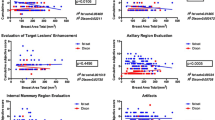Abstract
Purpose
To generate and evaluate fat-saturated T1-weighted (FST1W) image synthesis of breast magnetic resonance imaging (MRI) using pix2pix.
Materials and methods
We collected pairs of noncontrast-enhanced T1-weighted an FST1W images of breast MRI for training data (2112 pairs from 15 patients), validation data (428 pairs from three patients), and test data (90 pairs from 30 patients). From the original images, 90 synthetic images were generated with 50, 100, and 200 epochs using pix2pix. Two breast radiologists evaluated the synthetic images (from 1 = excellent to 5 = very poor) for quality of fat suppression, anatomic structures, artifacts, etc. The average score was analyzed for each epoch and breast density.
Results
The synthetic images were scored from 2.95 to 3.60; the best was reduction in artifacts when using 100 epochs. The average overall quality scores for fat suppression were 3.63 at 50 epochs, 3.24 at 100 epochs, and 3.12 at 200 epochs. In the analysis for breast density, each score was significantly better for nondense breasts than for dense breasts; the average score was 2.88–3.18 for nondense breasts and 3.03–3.42 for dense breasts (P = 0.000–0.042).
Conclusion
Pix2pix had the potential to generate FST1W synthesis for breast MRI.



Similar content being viewed by others
References
American college of radiology breast imaging reporting and data system (BI-RADS), vol 2013, 5th edn. American College of Radiology, Reston, VA
Shin K, Phalak K, Hamame A, Whitman GJ. Interpretation of breast MRI utilizing the BI-RADS Fifth Edition Lexicon: how are we doing and where are we headed? Curr Probl Diagn Radiol. 2017;46:26–34.
Mann RM, Kuhl CK, Kinkel K, Boetes C. Breast MRI: guidelines from the European Society of Breast Imaging. Eur Radiol. 2008;18:1307–18.
Kuhl C. The current status of breast MR imaging. Part I. Choice of technique, image interpretation, diagnostic accuracy, and transfer to clinical practice. Radiology. 2007;244:356–78.
Clauser P, Pinker K, Helbich TH, Kapetas P, Bernathova M, Baltzer PAT. Fat saturation in dynamic breast MRI at 3 Tesla: is the dixon technique superior to spectral fat saturation? A visual grading characteristics study. Eur Radiol. 2014;24:2213–9.
Le-Petross H, Kundra V, Szklaruk J, Wei W, Hortobagyi GN, Ma J. Fast three-dimensional dual echo Dixon technique improves fat suppression in breast MRI. J Magn Reson Imaging. 2010;31:889–94.
Dogan BE, Ma J, Hwang K, Liu P, Yang WT. T1-weighted 3D dynamic contrast-enhanced MRI of the breast using a dual-echo Dixon technique at 3 T. J Magn Reson Imaging. 2011;34:842–51.
Yi X, Walia E, Babyn P. Generative adversarial network in medical imaging: A review. Med Image Anal. 2019;58:101552.
Isola P, Zhu J-Y, Zhou T, Efros AA (2017) Image-to-image translation with conditional adversarial networks. Proceedings of the IEEE conference on computer vision and pattern recognition
Kaji S, Kida S. Overview of image-to-image translation by use of deep neural networks: denoising, super-resolution, modality conversion, and reconstruction in medical imaging. Radiol Phys Technol. 2019. https://doi.org/10.1007/s12194-019-00520-y.
van der Velden TA, Luijten PR, Klomp DWJ. Improved fat suppression of the breast using discretized frequency shimming. Magn Reson Med. 2018;79:593–9.
Guan S, Loew M. Breast cancer detection using synthetic mammograms from generative adversarial networks in convolutional neural networks. J Med Imaging (Bellingham). 2019;6:031411.
Kim KH, Do WJ, Park SH. Improving resolution of MR images with an adversarial network incorporating images with different contrast. Med Phys. 2018;45:3120–31.
Quan TM, Nguyen-Duc T, Jeong WK. Compressed sensing MRI reconstruction using a generative adversarial network with a cyclic loss. IEEE Trans Med Imaging. 2018;37:1488–97.
Wang Y, Yu B, Wang L, Zu C, Lalush DS, Lin W, et al. 3D conditional generative adversarial networks for high-quality PET image estimation at low dose. Neuroimage. 2018;174:550–62.
Wolterink JM, Leiner T, Viergever MA, Isgum I. Generative adversarial networks for noise reduction in low-dose CT. IEEE Trans Med Imaging. 2017;36:2536–45.
Tetko IV, Livingstone DJ, Luik AI. Neural network studies. 1. Comparison of overfitting and overtraining. J chem Inf Comput Sci. 1995;35:826–33.
Acknowledgements
The authors would like to thank Enago (www. Enago.jp) for the English language review.
Funding
This research received the 2019 Bayer Research Grant of the Japan Radiological Society.
Author information
Authors and Affiliations
Corresponding author
Ethics declarations
Conflict of interest
The authors declare that they have no conflict of interest.
Additional information
Publisher's Note
Springer Nature remains neutral with regard to jurisdictional claims in published maps and institutional affiliations.
About this article
Cite this article
Mori, M., Fujioka, T., Katsuta, L. et al. Feasibility of new fat suppression for breast MRI using pix2pix. Jpn J Radiol 38, 1075–1081 (2020). https://doi.org/10.1007/s11604-020-01012-5
Received:
Accepted:
Published:
Issue Date:
DOI: https://doi.org/10.1007/s11604-020-01012-5




